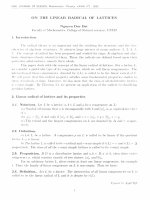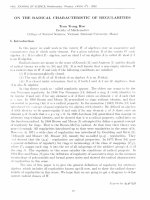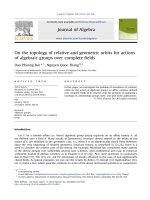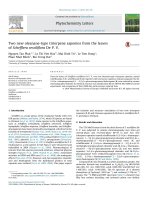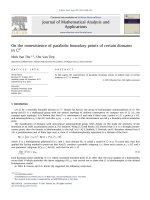DSpace at VNU: Is the learning approach of students from the Confucian heritage culture problematic?
Bạn đang xem bản rút gọn của tài liệu. Xem và tải ngay bản đầy đủ của tài liệu tại đây (147.47 KB, 9 trang )
Educ Res Policy Prac (2013) 12:57–65
DOI 10.1007/s10671-012-9131-3
Is the learning approach of students from the Confucian
heritage culture problematic?
Thi Tuyet Tran
Received: 4 October 2010 / Accepted: 22 February 2012 / Published online: 13 March 2012
© Springer Science+Business Media B.V. 2012
Abstract This article is concerned with the learning style adopted by Asian students who
come from a Confucian heritage culture (CHC) such countries as China, Vietnam, Singapore,
Korea and Japan are considered countries with Confucian heritage culture (Phuong-Mai et al.
2005). These students are generally viewed as typically passive, unwilling to ask questions or
speak up in class and often based on memorising rather than understanding knowledge delivered by teachers. This learning style is claimed to be shaped by the CHC in Asian countries
and receives massive criticism in the literature. This article aims to challenge this criticism
of the passive learning style adopted by Asian students who come from the CHC. By conducting in-depth interviews with 10 Asian students from the CHC currently studying tertiary
education in Australia, this article addresses the confusion between passive learning style
and CHC, between memorising and understanding and between quietness and passiveness.
Finally, if passiveness of Asian students is indeed observed in both Asian CHC countries
and English-speaking countries, it is more because of situation-specific factors of teaching
methodologies, learning requirements, learning habits and language proficiency rather than
cultural factors.
Keywords Higher education · Learning style · Asian students · Confucian heritage
culture · Passiveness
1 Introduction
There is a perception that Asian students are surface learners, often rely upon rote learning
and have passive learning style (Holliday 1994; Subramaniam 2008). They are viewed as passive, exhibiting compliance and obedience, and concerned only with absorbing knowledge
rather than understanding it (Purdie et al. 1996). This passive learning style is often attributed
T. T. Tran (B)
La Trobe University, Melbourne, VIC, Australia
e-mail:
T. T. Tran
Vietnam National University, Hanoi, Vietnam
123
58
T. T. Tran
to “Confucian values” and is considered attached to the Asian CHC. It is also considered in
contrast to the Western student learning style, which is described as assertive, independent,
self-confident and willing to ask questions and explore ways of thinking and acting (Purdie
et al. 1996). Asian students are criticized for having a passive learning style, not thinking
deeply and not being critical enough in learning, likely leading to low-quality outcomes.
This article aims to challenge this criticism of the Asian student passive learning style. It
addresses the confusion between passive learning style and CHC, between memorising and
understanding and between quietness and passiveness. Finally, if passiveness of Asian students is indeed observed in both Asian and English-speaking countries, it is more because of
situation-specific factors of teaching methodologies, learning requirements, learning habits
and language proficiency rather than cultural factors.
2 The argument over the “Confucian” learning approach
Asian students have been viewed as typically passive, shy and unwilling to ask questions or
speak up in class. Holliday (1994) suggests that, in Asian culture, the teacher is considered the
“fount of knowledge, which is delivered without any concession to students”, and students
must “struggle to attain” the knowledge delivered by the teacher (p. 59). Similarly, Pratt et al.
(1999) claim that many Asian students view the teacher’s responsibility as content delivery,
while the student’s responsibility is to absorb it. Subramaniam (2008) also suggests that the
majority of Asian students “attempt to maintain a sense of harmony; are hesitant to stand out as
individuals; rely on teachers to impart knowledge; and expect teachers to evaluate their learning” (p. 11). It is a popular comment that Asian students believe that learning is simply memorisation of knowledge in books or provided by teachers in class (Kennedy 2002). Thus, they are
claimed to be reluctant to participate in classroom activities, to be unwilling to give responses,
to avoid asking questions and to be over-dependent on the teacher (Braddock et al. 1995;
Cortazzi and Jin 1996). The picture of passive Asian learners in a teacher-dominated classroom is common in the literature (Flowerdew and Miller 1995; Scollon and Scollon 1994).
The tendency for passive learning amongst Asian students has been explained in terms of
the effects of the traditional learning style and the cultural background of students (Flowerdew
and Miller 1995; Nguyen 2002, p. 4; Pierson 1996; Scollon and Scollon 1994; Thompson
2009, p. 23). It is explained that Asian culture is considered to be a CHC, and its students
are viewed as passive, reproductive and surface learners (Jones 1999, p. 3). In the CHC,
children are taught to respect people who are older and who have higher rank, i.e. parents,
elders and teachers (Ramburuth and McCormick 2001). Therefore, the teacher’s knowledge
and wisdom are often taken for granted and not to be questioned. The concept of face is also
important in this culture. It is considered selfish and shameful to cause someone to lose face
(Bond 1996). All these factors are used to explain the passiveness of Asian students.
This passive and reproductive learning style of Asian students has received massive criticism in the literature. Some scholars criticize teaching in Asian countries as a didactic,
spoon-feeding approach where students are to believe that learning consists of memorising
knowledge given by the teacher (Kennedy 2002; McKay and Kember 1997). This teaching
approach is viewed as de-motivating students from adopting a deep approach or thinking
critically (McKay and Kember 1997). Thus, students in these systems often prefer to absorb
knowledge from the teacher without their own critical thinking. They are criticized as rote
learners who do not want to think more deeply (Ballard and Clanchy 1984; Marton and
Dall’Alba 1996; Pratt et al. 1999). They are even viewed as perplexed, deficient and handicapped by some Western scholars (Mestenhauser 1983; Pedersen 1991). These views on
123
Confucian heritage culture
59
Asian students are often in contrast to views on Western students, who are described as
assertive, critical, independent, self-confident and willing to ask questions and raise their
own voices (Purdie et al. 1996). A common conclusion is that the passive learning style
with mainly learning by memorising of Asian students is only the process of memorising
information in order to reproduce information, often leading to low-quality outcomes, while
the active learning style of Western students is viewed as the process of understanding, making sense of information and making it meaningful, thus leading to high-quality outcomes
(Dahalin and Watkins 2000).
However, the contested and blanket assumptions that many authors make about the socalled Asian passive learning approach should be challenged. With experience of more than
10 years teaching in Vietnam, and more than 5 years studying and teaching international
students in Australia, many of whom are Asian students, I instinctively distrust this myth.
From my own teaching experience and my numerous class observations, some Asian students are indeed passive, but many are very active, and some even more critical than their
Western classmates. The notion that Asian students are passive learners, I will argue, is
over-generalized.
3 Research methodology
To reconsider the learning style adopted by students from the CHC and also challenge my own
thinking, I conducted qualitative research with participants from countries with a CHC. The
study was conducted by in-depth interviews with 10 Asian students from China, Vietnam,
Singapore, Thailand and Korea who are currently studying tertiary education in Australia.
I presented the perceptions in the literature on Asian CHC students’ learning style and asked
for their reflections. To minimise my influence on participants, the interview questions were
open, and the probing technique was employed in conducting the interviews. Probing definitely does not mean prompting, but “the correct response is a probe that does not put words
into respondent’s mouth” (Bernard and Ryan 2010, p. 31). In addition, I also understand
that “local meanings are important” (Stake 2008, p. 128) and that the voices of the participants provide much valuable information. I also have a particular interest in listening to their
voices. This interest will draw my understanding toward what is important in the world of
the participants, which may not be the same as my world.
4 Research results
4.1 The questionable link between passive learning style and CHC
In contrast to the criticism of the passive learning style of students coming from the CHC,
most students did not see many negative points of their culture that impacted on their study.
Though they all seemed to agree that they come from a totally different culture and learning
environment from those in Australia, they think that their study style is neither shaped by
their culture nor passive.
First, in terms of their culture, these young people (all aged from 19 to 24 years) suggested
that, as they were born and grew up in the information and globalization era, they were more
flexible than their previous generations in terms of “maintaining” cultural values. Some of
them did not even know or agree that they belong to the CHC. However, in a class setting, they
all wanted to show respect to their teachers, but then, they saw no problem with respecting
teachers. One student put it as follows:
123
60
T. T. Tran
Teachers are knowledgeable. They are deserved respect from students. I think teachers
will teach better if they know they are respected. However, respecting teacher does not
mean that we are passive or obedient. We just have a different way to convey our ideas.
Students also did not think that the teacher’s knowledge and wisdom should be taken for
granted and not be questioned. One student expressed his thoughts as follows:
I don’t agree that we think teacher is “a fount of knowledge”. We now all understand
that teachers are also human being, and cannot know everything. However we don’t
usually like the idea of confronting them in front of the whole class. We normally
choose to discuss our own opinions with other classmates to confirm our understanding, or we may talk with the teacher after the class or on the discussion forum. It saves
teacher’s face and also save time for the whole class learning.
So, face-saving does seem to exist in these students’ minds. However, maintaining face
for teachers does not mean that they have to keep their mouths shut, or not confront teachers’
opinions. Nonetheless, they have to find other ways to express themselves, which may not
be as strong, straightforward and critical as Western students’ ways.
Most students were strongly against the allegation that they learn passively. One student
explained:
We are not passive. We just have to handle the differences. In our country, everything
is given to us by the teacher. They give us assignments, they give us readings, they
lecture and we just take notes. We also do not have to care much about English language, English academic writing, plagiarism, referencing etc. Coming here, everything
changes, we have to struggle with English and a very different writing style, we have
to do lots of reading and find the reading ourselves. No one is there to show us how. So
most of us have to “find a needle in the dark” for the first semester or the first year, but
from the second semester, I think, we all feel much more relax and can get involved
into class activities easily.
In short, most students were against the idea that cultural influences make them passive
in their learning, though they agreed that cultural habits may make them respond to the same
problem differently from local students. They tend to be passive when teachers provide everything for them to learn and when tests are designed to recheck knowledge given by teachers.
This passiveness is shaped by the requirements of the course rather than by the cultural
factors. Coming to Australia, where active learning is prioritized, they have to struggle to
adopt the new learning style. They also have to handle many problems during this transition,
such as the language barrier, different teaching styles and different learning environment and
requirements. However, they all suggested that, when they get used to “the way” of learning in Australia, the learning here, for them, is even easier than studying at universities in
their countries. Then, if they do come here for the purpose of study rather than for work or
migration, and they focus on their studies, studying here is not a big problem for them.
4.2 Memorising versus understanding
The interviewed students offered very interesting opinions when they recalled their learning
process:
I remember I did employ rote learning at school for such subjects as geography or history. We just learnt by heart for the exam; after the exam we got rid of the information
123
Confucian heritage culture
61
from our minds. I focused on only mathematics, physics and chemistry – those were
subjects I had to take in university entrance exam.
Another student offered the following explanation for their rote learning:
The reason we had to learn by heart without truly understanding the thing is because
the curriculum was too theory-focus. We had to study so many things within so little
time. We were too little, so many terms were new, and without any visual aids, we could
not really understand them. But for the requirements of the exam, we had to memorise
them.
However, most students were against the idea that they can employ the same technique of
rote learning at tertiary level, especially at overseas universities:
It seems impossible to me to memorise something in English without understanding it.
Actually we find it easier to understand something than to merely memorise it. That’s
why sometimes we understand, but we could not express ourselves.
This is probably why they all retained a desire to remember the knowledge they learn. Most
students suggested that it was hard to distinguish between memorising and understanding.
For them, memorising and understanding are two sides of the same coin. However, not all of
them seemed to agree with Marton and Dall’Alba (1996) and Tavakol and Dennick (2010)
that the relation between memorising and understanding is memorising preceding understanding, as for them, sometimes they need to understand the subject matter before they can
start the memorising process. Sometimes, however, during the process of memorising, they
try to make sense of the knowledge, so they can remember it more easily. Overall, they need
to change their learning approach when the requirement of the course changes. If the exam
only aims to recheck knowledge they have learnt, they focus more on memorising. However,
they all suggested that, at tertiary level in Australia, without truly understanding, it seemed
impossible for them to tackle the tasks in different tertiary subjects.
Finally, the interviewed students all seemed to agree that, as students, they all want to
focus on the learning tasks in the form of either assignments or exams. They may use different strategies to prepare for and carry out the tasks. Memorising and understanding are
considered two sides of the same coin, but sometimes they need to focus more on one strategy
than the other in order to get the highest mark possible. This comment seems to be supported
by Biggs (1993) argument that the learner’s intentions in carrying out learning tasks are more
important in determining the particular approach to learning than the actual strategies used.
4.3 Does quietness mean passiveness?
Five out of 10 students claimed that they were normally not quieter than other students in
their classes. They did get involved in tutorials, they did ask their tutors questions and they
often actively got involved in group discussions. Interestingly, they all seemed to agree that,
in general, Asian students do appear to be quite quiet in class. However, they did not see
quietness as passiveness. Reasons for not speaking out during class time varied. Some blamed
their quietness on their level of English proficiency:
My English is not so good, so during the lecture, I just try to understand the lesson.
or
123
62
T. T. Tran
Sometimes I do come up with some kinds of questions, but I have problem of finding
words and the right expression. I do not have much time for thinking, so I just choose
not to speak. I may ask a classmate later.
A business student suggested that sometimes they were out of context:
They discuss about, for example, a company in Australia or Europe which I have no
idea about. In that context, what can I say? If they discuss about a big company that I
know in China, I will of course express my own opinion.
However, there are also some students who suffer from fear of asking, especially when
other students appear to understand. They think that in that case they should also understand,
and if they do not, they should ask a classmate after the class. Interestingly, most students
did not support the idea of interrupting the lecture too often to ask for small details. Some of
them even criticized local students for asking too many questions during lecture time:
Our lecturer never finishes his lecture notes, and sometimes he has to skip some important parts. Some students in the class are so annoying; sometimes they ask “stupid”
questions. If they read text book and listen to the lecture carefully, they will have all
answers for their questions. They take away too much time for the whole class.
Obviously, these Asian students do hold a different view about the appropriateness of
speaking out in class. Though the language barrier does indeed contribute to their quietness
in Australian universities, they do not see quietness as passiveness, and sometimes they see
quietness as necessary and supportive for a productive learning environment. Most of them
try hard to understand by reading and listening, and sometimes by questioning each other
after class time.
4.4 Why does the claim of passivity of Asian students seem to be popular?
As the interviewed students all seemed to be confident and not to accept the criticism that
Asian students are passive in learning, the question is: Why is the claim of the passivity of
Asian students still so popular, or are the interviewed students different from the majority of
Asian students? This question made them think harder to find a reason. One student appeared
suspicious:
When was the claim? Is it recent? Or was it 10 or 20 years ago? Things are changing
rapidly, and even our parents have to say that we are so different from them when they
went to school or university.
Another student did not give a direct answer, but instead posed a challenge:
Are all Asian students the same? I am Singaporean, and I don’t think I am the same
like Vietnamese, Thai, or Japanese students. And even in the same class in Singapore,
we may have some very active students and some very passive ones.
May, a social science student, suggested
I think because many students from rich families in Asian countries come here not
really for study. They may not pass the exam to universities in their countries, or they
just want to study for a degree to immigrate. Most of these students are passive or even
lazy in class.
123
Confucian heritage culture
63
In general, most students agreed that the answer must depend on the situation:
I think it depends on the context then. If the teacher gives you everything, they even
read for you to copy, and then in the exam, you just need to rewrite the content, you
will naturally base on the teacher.
or on the teacher’s methodology:
Teacher’s teaching methodology is very important. Some teachers at my secondary
school in Vietnam did not require us to be active. They even felt annoyed when we
have some opinions against their opinions.
and also on the course requirement:
Actually teacher’s methodology and course requirement are both very important. In my
university in China, we have some classes called “high quality classes” where teachers
always encourage students to give out opinions; they give us a lots of group work and
research work, and we do group work and write assignment instead of taking exam.
Students in those classes, I think, are even more active than many students in my classes
in Australia now.
Overall, the claim of passivity of Asian students does appear over-generalized for these
Asian students. There are cases where students seem to be passive, but there is a need to
determine the reasons for that passivity. Rather than cultural factors, the teaching methodology of the teachers and the learning requirements are two of the important factors shaping
student learning style. Some Asian students may come from a teaching and learning context
that does not require their activeness. It takes time for them to adapt to the Australian learning
context, where activeness is required and desirable.
4.5 Support from previous research
The above findings challenge the idea of labelling Asian students as passive learners. These
findings are also supported by many authors who are against the criticism of Asian students’
learning style; For example, Biggs (1995, 1996); Marton et al. (1993) and Renshaw and Volet
(1995) all point to the paradox wherein Asian students are labelled as both “rote learners” and
“brainy Asians” who excel in their academic studies abroad. Kennedy (2002) also wonders
whether Asian students may be not passive but reflective. Biggs (1990, 1993), on the other
hand, conducted many studies using the Studies Process Questionnaire, finding that Asian
students consistently score higher on deep approaches and lower on surface approaches to
learning than Australian students. Kember and Gow (1991) research findings also support
Bigg’s argument when they suggest that Asian international students take deeper approaches
to learning than Western students. However, Ramburuth and McCormick (2001), who also
used the Study Process Questionnaire (Biggs 1987) and Perceptual Learning Style Preference
Questionnaire (Reid 1987) as research tools, come to a quite different conclusion:
In their overall approaches to learning, the Asian international students may not be
very different from Australian students. The evidence refutes, to some extent, anecdotal and stereotypical claims in the literature (for example, in Ballard and Clanchy
1991; Samuelowicz 1987; Phillips 1990 suggesting that international students from
Asian backgrounds employ more surface approaches to learning than Australian students). At the same time, there is no support for the proposition by Biggs (1990) that
123
64
T. T. Tran
Asian students are generally higher in their deep approach to learning when compared
to Australian students. (p. 346)
Similarly, Kember (2000) also uses evidence from over 90 action research projects to
disprove the common assertions that Asian students prefer passive learning. He explains that
“students will adopt a surface approach if they perceive that is what the course and assessment requires or if that approach best enables them to deal with the demands of the course”
(p. 108). He also suggests that Asian students can and do adjust to active forms of learning
if given the opportunity (p. 101). Volet et al. (1994) research finding is also congruent with
Kember’s finding that learning approaches are influenced by students’ perceptions of course
requirements rather than being determined by personal characteristics or cultural differences.
5 Conclusions
This article argues that the claim of a passive learning style of Asian students who come
from the CHC is an over-generalization. Evidence from direct interviews with students and
from previous research is very supportive of this argument. There is also evidence of confusion between a passive learning style and CHC, between memorising and understanding
and between quietness and passivity. Culture could be one factor affecting student behaviour and reaction in class. Students from the CHC may hold a different perspective on the
appropriateness of behaviours and reactions in the classroom environment. However, such
differences should not be confused with passiveness, as the decisive factors affecting students’ activeness or passiveness come from the specific educational system, its requirements,
the workload placed on students and also related issues of curricula, exams, teaching methodology and other specific problems related to student study context and environment. Students
will become passive if that is shaped by the system, and if they move to a more active learning environment, it takes time for the transition, and they also need help and guidance to
recognise and handle the differences and adapt.
References
Ballard, B., & Clanchy, J. (1984). Study abroad: A manual for Asian students. Kuala Lumpur: Longmans.
Ballard, B., & Clanchy, J. (1991). Teaching students from overseas: A brief guide for lecturers and
supervisors. Melbourne: Longman Cheshire.
Bernard, H. R., & Ryan, G. W. (2010). Analysing qualitative data: Systemic aproaches. London: Sage.
Biggs, J. B. (1987). Study process questionnaire. Melbourne: Australian Council for Educational Research.
Biggs, J. B. (1990). Asian students’ approaches to learning: Implications for teaching and learning. Paper
presented at the The 8th Australasian Tertiary Learning Skills and Language Conference, Brisband,
Australia.
Biggs, J. B. (1993). What do inventories of students’ learning processes really measure? A theoretical
review and clarification. British Journal of Educational Psychology, 63, 3–19.
Biggs, J. B. (1995). Student approaches to learning, constructivism, and student-centred learning.
Paper presented at the The Twentieth International Conference on Improving University Teaching,
Hong Kong.
Biggs, J. B. (1996). Western misconceptions of the Confucian-heritage learning culture. In D. A. Watkins & J. B. Biggs (Eds.), The Chinese learner: Cultural, psychological and contextual influences (pp.
45–67). Hong Kong: CERC and ACER.
Bond, M. (1996). The handbook of Chinese psychology. Hong Kong: Oxford University Press.
Braddock, R., Roberts, P., Zheng, C., & Guzman, T. (1995). Survey on skill development in intercultural
teaching of international students. Sydney: Macquarie University, Asian Pacific Research Institute.
Cortazzi, M., & Jin, L. (1996). Cultures of learning: Language classrooms in China. In H. Coleman (Ed.), Society and the language classroom (pp. 169–206). Cambridge: Cambridge University Press.
123
Confucian heritage culture
65
Dahalin, B., & Watkins, D. (2000). The role of repetition in the processes of memorising and understanding:
A comparison of the views of German and Chinese secondary school students in Hong Kong. British
Journal of Educational Psychology, 70, 65–84.
Flowerdew, J., & Miller, L. (1995). On the notion of culture in L2 lectures. TESOL Quarterly, 29(2), 345–373.
Holliday, A. (1994). Appropriate methodology and social context. Cambridge: Cambridge University press.
Jones, A. (1999). The Asian learner: An overview of approaches to learning. Melbourne: The University
of Melbourne.
Kember, D. (2000). Misconceptions about the learning approaches, motivation and study practices of
Asian students. Higher Education, 40, 99–121.
Kember, D., & Gow, L. (1991). A Challenge to the Anecdotal Stereotype of the Asian Student. Studies
in Higher Education, 16, 117–128.
Kennedy, P. (2002). Learning cultures and learning styles: Myth-understandings about adult (Hong Kong)
Chinese learners. International Journal of Lifelong Education, 21(5), 430–445.
Marton, F., & Dall’Alba, G. (1996). Memorising and understanding: The keys to the paradox. In
D. A. Watkins & J. B. Biggs (Eds.), The Chinese learner: Cultural, psychological, and contextual
influences.. Hong Kong: Comparative Education Research Centre.
Marton, F., Dall’Alba, G., & Tse, K. L. (1993). The Paradox of the Chinese Learner (Occasional Paper
No. 93.1). Victoria, Australia: Royal Melbourne Institute of Technology, Educational Research and
Development Unit.
McKay, J., & Kember, D. (1997). Spoonfeeding leads to regurgitation: A better diet can result in more
digestible learning outcomes. Higher Education Research and Development, 16(1), 55–67.
Mestenhauser, J. (1983). Learning from sojourners. In D. Landis & R. W. Brislin (Eds.), Handbook of
intercultural training. Elmsford, NY: Pergamon.
Nguyen, T. H. (2002). Vietnam: Cultural background for ESL/EFL teachers. Review of Vietnamese
Studies, 2(1), 1–6.
Pedersen, P. (1991). Counselling international students. The Counselling Psychologist, 19, 10–58.
Phillips, D. J. (1990). Overseas students and their impact on the changing face of professional education
in universities. Paper presented at the Australian Association for Research in Education Annual
Conference, Sydney University, Australia.
Phuong-Mai, N., Terlouw, C., & Pilot, A. (2005). Cooperative learning vs Confucian heritage culture’s collectivism: Confrontation to reveal some cultural conflicts and mismatch. Asia Europe
Journal, 3(3), 403–419.
Pierson, H. (1996). Learner culture and learner autonomy in the Hong Kong Chinese context. In R. Pemberton, E. Li, & W. Or (Eds.), Taking control: Autonomy in language learning (pp. 49–58). Hong
Kong: Hong Kong University Press.
Pratt, D., Kelly, M., & Wong, W. S. S. (1999). Chinese conceptions of ‘effective teaching’ in Hong
Kong: Towards culturally sensitive evaluation of teaching. International Journal of Lifelong Learning
Education, 18, 241–258.
Purdie, N., Hattie, J., & Douglas, G. (1996). Student conceptions of learning and their use of self-regulated
learning strategies: A cross-cultural comparison. Journal of Educational Psychology, 88, 87–100.
Ramburuth, P., & McCormick, J. (2001). Learning diversity in higher education: A comparative study of
Asian international and Australian students. Higher Education, 42, 333–350.
Reid, J. M. (1987). The learning style preferences of ESL students. TESOL Quarterly, 21(1), 87–111.
Renshaw, P., & Volet, S. (1995). South East Asian students at Australian universities: A reappraisal of their
tutorial participation and approaches to study. Australian Educational Researcher, 22(2), 85–106.
Samuelowicz, K. (1987). Learning problems of overseas students: Two sides of a story. Higher Education
Research and Development, 6(2), 121–133.
Scollon, R., & Scollon, S. (1994). The post-Confucian confusion. Research report no. 37. Hong Kong:
City Polytechnic of Hong Kong.
Stake, R. E. (2008). Qualitative case study. In N. K. Denzin & Y. S. Lincold (Eds.), Strategies of qualitative
inquiry (pp. 119–150). London: Sage.
Subramaniam, G. (2008). Confronting Asian concerns in engaging learners to online education. International
Education Studies, 1(4), 10–18.
Tavakol, M., & Dennick, R. (2010). Are Asian international medical students just rote learners?. Advances
in Health Sciences Education, 15, 369–377.
Thompson, J. (2009). Changing chalk and talk: The reform of teaching methods in Vietnamesse higher
education. Independent study project paper. The George Washington University.
Volet, S., Renshaw, P., & Tietzel, K. (1994). A short term longitudinal investigation of cross-cultural
differences in study approaches using Biggs’ SPQ questionaire. British Journal of Educational
Psychology, 64, 301–318.
123

